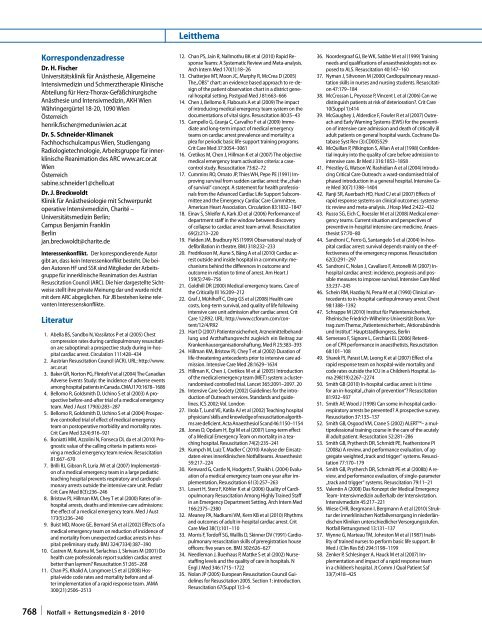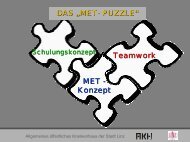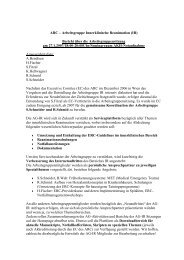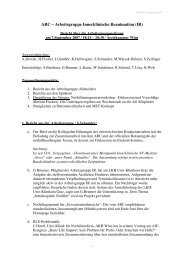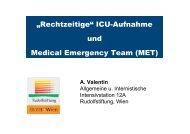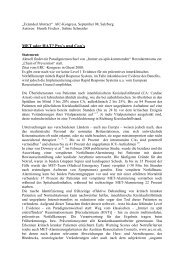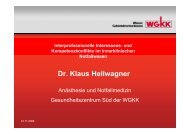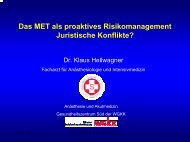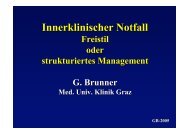„Medical emergency team” und Reanimationsteam - Austrian ...
„Medical emergency team” und Reanimationsteam - Austrian ...
„Medical emergency team” und Reanimationsteam - Austrian ...
Erfolgreiche ePaper selbst erstellen
Machen Sie aus Ihren PDF Publikationen ein blätterbares Flipbook mit unserer einzigartigen Google optimierten e-Paper Software.
LeitthemaKorrespondenzadresseDr. H. FischerUniversitätsklinik für Anästhesie, AllgemeineIntensivmedizin <strong>und</strong> Schmerztherapie KlinischeAbteilung für Herz-Thorax-GefäßchirurgischeAnästhesie <strong>und</strong> Intensivmedizin, AKH WienWähringergürtel 18-20, 1090 WienÖsterreichhenrik.fischer@meduniwien.ac.atDr. S. Schneider-KlimanekFachhochschulcampus Wien, StudiengangRadiologietechnologie, Arbeitsgruppe für innerklinischeReanimation des ARC www.arc.or.atWienÖsterreichsabine.schneider1@chello.atDr. J. BreckwoldtKlinik für Anästhesiologie mit Schwerpunktoperative Intensivmedizin, Charité –Universitätsmedizin Berlin;Campus Benjamin FranklinBerlinjan.breckwoldt@charite.deInteressenkonflikt. Der korrespondierende Autorgibt an, dass kein Interessenkonflikt besteht. Die beidenAutoren HF <strong>und</strong> SSK sind Mitglieder der Arbeitsgruppefür innerklinische Reanimation des <strong>Austrian</strong>Resuscitation Council (ARC). Die hier dargestellte Sichtweisestellt ihre private Meinung dar <strong>und</strong> wurde nichtmit dem ARC abgeglichen. Für JB bestehen keine relevantenInteressenskonflikte.Literatur1. Abella BS, Sandbo N, Vassilatos P et al (2005) Chestcompression rates during cardiopulmonary resuscitationare suboptimal: a prospective study during in-hospitalcardiac arrest. Circulation 111:428–4342. <strong>Austrian</strong> Resuscitation Council (ACR). URL: http://www.arc.or.at3. Baker GR, Norton PG, Flintoft V et al (2004) The CanadianAdverse Events Study: the incidence of adverse eventsamong hospital patients in Canada. CMAJ 170:1678–16864. Bellomo R, Goldsmith D, Uchino S et al (2003) A prospectivebefore-and-after trial of a medical <strong>emergency</strong>team. Med J Aust 179(6):283–2875. Bellomo R, Goldsmith D, Uchino S et al (2004) Prospectivecontrolled trial of effect of medical <strong>emergency</strong>team on postoperative morbidity and mortality rates.Crit Care Med 32(4):916–9216. Boniatti MM, Azzolini N, Fonseca DL da et al (2010) Prognosticvalue of the calling criteria in patients receivinga medical <strong>emergency</strong> team review. Resuscitation81:667–6707. Brilli RJ, Gibson R, Luria JW et al (2007) Implementationof a medical <strong>emergency</strong> team in a large pediatricteaching hospital prevents respiratory and cardiopulmonaryarrests outside the intensive care unit. PediatrCrit Care Med 8(3):236–2468. Bristow PJ, Hillman KM, Chey T et al (2000) Rates of inhospitalarrests, deaths and intensive care admissions:the effect of a medical <strong>emergency</strong> team. Med J Aust173(5):236–2409. Buist MD, Moore GE, Bernard SA et al (2002) Effects of amedical <strong>emergency</strong> team on reduction of incidence ofand mortality from unexpected cardiac arrests in hospital:preliminary study. BMJ 324(7334):387–39010. Castren M, Kuisma M, Serlachius J, Skrivars M (2001) Dohealth care professionals report sudden cardiac arrestbetter than laymen? Resuscitation 51:265–26811. Chan PS, Khalid A, Longmore LS et al (2008) Hospital-widecode rates and mortality before and afterimplementation of a rapid response team. JAMA300(21):2506–251312. Chan PS, Jain R, Nallmothu BK et al (2010) Rapid ResponseTeams: A Systematic Review and Meta-analysis.Arch Intern Med 170(1):18–2613. Chatterjee MT, Moon JC, Murphy R, McCrea D (2005)The „OBS“ chart: an evidence based approach to re-designof the patient observation chart in a district generalhospital setting. Postgrad Med J 81:663–66614. Chen J, Bellomo R, Flabouris A et al (2009) The impactof introducing medical <strong>emergency</strong> team system on thedocumentations of vital signs. Resuscitation 80:35–4315. Campello G, Granja C, Carvalho F et al (2009) Immediateand long-term impact of medical <strong>emergency</strong>teams on cardiac arrest prevalence and mortality: aplea for periodic basic life-support training programs.Crit Care Med 37:3054–306116. Cretikos M, Chen J, Hillman K et al (2007) The objectivemedical <strong>emergency</strong> team activation criteria: a casecontrolstudy. Resuscitation 73:62–7217. Cummins RO, Ornato JP, Thies WH, Pepe PE (1991) Improvingsurvival from sudden cardiac arrest: the „chainof survival“ concept. A statement for health professionalsfrom the Advanced Cardiac Life Support Subcommitteeand the Emergency Cardiac Care Committee,American Heart Association. Circulation 83:1832–184718. Einav S, Shleifer A, Kark JD et al (2006) Performance ofdepartment staff in the window between discoveryof collapse to cardiac arrest team arrival. Resuscitation69(2):213–22019. Fielden JM, Bradbury NS (1999) Observational study ofdefibrillation in theatre. BMJ 318:232–23320. Fredriksson M, Aune S, Bång A et al (2010) Cardiac arrestoutside and inside hospital in a community: mechanismsbehind the differences in outcome andoutcome in relation to time of arrest. Am Heart J159(5):749–75621. Goldhill DR (2000) Medical <strong>emergency</strong> teams. Care ofthe Critically Ill 16:209–21222. Graf J, Mühlhoff C, Doig GS et al (2008) Health carecosts, long-term survival, and quality of life followingintensive care unit admission after cardiac arrest. CritCare 12:R92. URL: http://www.ccforum.com/content/12/4/R9223. Hart D (2007) Patientensicherheit, Arzneimittelbehandlung<strong>und</strong> Arzthaftungsrecht zugleich ein Beitrag zurKrankenhausorganisationshaftung, Med R 25:383–39324. Hillman KM, Bristow PJ, Chey T et al (2002) Duration oflife-threatening antecedents prior to intensive care admission.Intensive Care Med 28:1629–163425. Hillman K, Chen J, Cretikos M et al (2005) Introductionof the medical <strong>emergency</strong> team (MET) system: a clusterrandomisedcontrolled trial. Lancet 365:2091–2097. 2026. Intensive Care Society (2002) Guidelines for the introductionof Outreach services. Standards and guidelines.ICS 2002; Vol. London27. Iirola T, L<strong>und</strong> VE, Katila AJ et al (2002) Teaching hospitalphysicians’ skills and knowledge of resuscitation algorithmsare deficient. Acta Anaesthesiol Scand 46:1150–115428. Jones D, Opdam H, Egi M et al (2007) Long-term effectof a Medical Emergency Team on mortality in a teachinghospital. Resuscitation 74(2):235–24129. Kumpch M, Luiz T, Madler C (2010) Analyse der Einsatzdateneines innerklinischen Notfallteams. Anaesthesist59:217–22430. Kenward G, Castle N, Hodgetts T, Shaikh L (2004) Evaluationof a medical <strong>emergency</strong> team one year after implementation.Resuscitation 61(3):257–26331. Losert H, Sterz F, Köhler K et al (2006) Quality of CardiopulmonaryResuscitation Among Highly Trained Staffin an Emergency Department Setting. Arch Intern Med166:2375–238032. Meaney PA, Nadkarni VM, Kern KB et al (2010) Rhythmsand outcomes of adult in-hospital cardiac arrest. CritCare Med 38(1):101–11033. Morris F, Tordoff SG, Walllis D, Skinner DV (1991) Cardiopulmonaryresuscitation skills of preregistration houseofficers: five years on. BMJ 302:626–62734. Needleman J, Buerhaus P, Mattke S et al (2002) Nursestaffinglevels and the quality of care in hospitals. NEngl J Med 346:1715–172235. Nolan JP (2005) European Resuscitation Council Guidelinesfor Resuscitation 2005. Section 1: introduction.Resuscitation 67(Suppl 1):3–636. Noordergraaf GJ, Be WK, Sabbe M et al (1999) Trainingneeds and qualifications of anaesthesiologists not exposedto ALS. Resuscitation 40:147–16037. Nyman J, Sihvonen M (2000) Cardiopulmonary resuscitationskills in nurses and nursing students. Resuscitation47:179–18438. McCrossan L, Peyrasse P, Vincent L et al (2006) Can wedistinguish patients at risk of deterioration?. Crit Care10(Suppl 1):41439. McGaughey J, Alderdice F, Fowler R et al (2007) Outreachand Early Warning Systems (EWS) for the preventionof intensive care admission and death of critically illadult patients on general hospital wards. Cochrane DatabaseSyst Rev (3):CD00552940. McQuillan P, Pilkington S, Allan A et al (1998) Confidentialinquiry into the quality of care before admission tointensive care. Br Med J 316:1853–185841. Priestley G, Watson W, Rashidian A et al (2004) IntroducingCritical Care Outreach: a ward-randomised trial ofphased introduction in a general hospital. Intensive CareMed 30(7):1398–140442. Ranji SR, Auerbach HD, Hurd CJ et al (2007) Effects ofrapid response systems on clinical outcomes: systematicreview and meta-analysis. J Hosp Med 2:422–43243. Russo SG, Eich C, Roessler M et al (2008) Medical <strong>emergency</strong>teams. Current situation and perspectives ofpreventive in-hospital intensive care medicine. Anaesthesist57:70–8044. Sandroni C, Ferro G, Santangelo S et al (2004) In-hospitalcardiac arrest: survival depends mainly on the effectivenessof the <strong>emergency</strong> response. Resuscitation62(3):291–29745. Sandroni C, Nolan J, Cavallaro F, Antonelli M (2007) Inhospitalcardiac arrest: incidence, prognosis and possiblemeasures to improve survival. Intensive Care Med33:237–24546. Schein RM, Hazday N, Pena M et al (1990) Clinical antecedentsto in-hospital cardiopulmonary arrest. Chest98:1388–139247. Schrappe M (2010) Institut für Patientensicherheit,Rheinische Friedrich-Wilhelms-Universität Bonn. Vortragzum Thema: „Patientensicherheit:, Aktionsbündnis<strong>und</strong> Institut”. Hauptstadtkongress, Berlin48. Semeraro F, Signore L, Cerchiari EL (2006) Retentionof CPR performance in anaesthetists. Resuscitation68:101–10849. Sharek PJ, Parast LM, Leong K et al (2007) Effect of arapid response team on hospital-wide mortality andcode rates outside the ICU in a Children’s Hospital. Jama298(19):2267–227450. Smith GB (2010) In-hospital cardiac arrest: is it timefor an in-hospital „chain of prevention“? Resuscitation81:932–93751. Smith AF, Wood J (1998) Can some in-hospital cardiorespiratoryarrests be prevented? A prospective survey.Resuscitation 37:133–13752. Smith GB, Osgood VM, Crane S (2002) ALERT– a multiprofessionaltraining course in the care of the acutelyill adult patient. Resuscitation 52:281–28653. Smith GB, Prytherch DR, Schmidt PE, Featherstone PI(2008a) A review, and performance evaluation, of aggregateweighted „track and trigger“ systems. Resuscitation77:170–17954. Smith GB, Prytherch DR, Schmidt PE et al (2008b) A review,and performance evaluation, of single-parameter„track and trigger“ systems. Resuscitation 79:11–2155. Valentin A (2008) Das Konzept der Medical EmergencyTeam- Intensivmedizin außerhalb der Intensivstation.Intensivmedizin 45:217–22156. Wiese CHR, Bergmann I, Bergmann A et al (2010) Strukturder innerklinischen Notfallversorgung in niederländischenKliniken unterschiedlicher Versorgungsstufen.Notfall Rettungsmed 13:131–13757. Wynne G, Marteau TM, Johnston M et al (1987) Inabilityof trained nurses to perform basic life support. BrMed J (Clin Res Ed) 294:1198–119958. Zenker P, Schlesinger A, Hauck M et al (2007) Implementationand impact of a rapid response teamin a children’s hospital. Jt Comm J Qual Patient Saf33(7):418–425768 | Notfall + Rettungsmedizin 8 · 2010


